Vessel Turnaround Time in Colombo Port: Factors and Strategies
Assessing the factors affecting vessel turnaround time in Colombo Port and finding ways to minimize it.
47 Pages14990 Words74 Views
Added on 2022-11-23
About This Document
This Business Dissertation discusses the need and consequence of lowering the vessel turnaround time in Colombo Port. It identifies the factors that impact the turnaround time and suggests strategies to minimize it. The study found that cargo transferring delay is the major cause of vessel turnaround delay and improving equipment quality can significantly help Colombo Port to minimize the delay.
Vessel Turnaround Time in Colombo Port: Factors and Strategies
Assessing the factors affecting vessel turnaround time in Colombo Port and finding ways to minimize it.
Added on 2022-11-23
ShareRelated Documents
FACTORS AFFECTING VESSEL TURNAROUND
TIME IN COLOMBO PORT
UNIT TITLE - BUSINESS DISSERTATION
UNIT CODE – MAR042-6
ASSIGNMENT NUMBER - 1 – PROPOSAL
SUBMISSION DEADLINE - 10AM 28/06/2019
NAME - H.M. KALANA MADURANGA
DIVULGANE
ID NO. - 1815407
VESSEL TURNAROUND TIME IN COLOMBO PORT
TIME IN COLOMBO PORT
UNIT TITLE - BUSINESS DISSERTATION
UNIT CODE – MAR042-6
ASSIGNMENT NUMBER - 1 – PROPOSAL
SUBMISSION DEADLINE - 10AM 28/06/2019
NAME - H.M. KALANA MADURANGA
DIVULGANE
ID NO. - 1815407
VESSEL TURNAROUND TIME IN COLOMBO PORT

1VESSEL TURNAROUND TIME IN COLOMBO PORT
Abstract
At port terminals, one of the most important factors related to customer satisfaction is
ship waiting time. As per the last Audit report of General of the National Economic
Council of Sri Lanka, the vessel turnaround time of Colombo Port has increased
significantly with the increasing number of cargo transportation. The purpose of this
research is to assess the need and consequence of lowering the turnaround time
while identifying the factors that have an impact on vessel turnaround time in
Colombo Port and to find the ways in which vessel turnaround time can be
minimised in Colombo Port.
In this research the literature review has been done where secondary data has been
collected and presented in thematic format. As research design for this research the
cross-sectional structured interview design has been used. In this research the
probability random sampling has been done to select 50 responses from the total
number of collected responses from the data collection through using a survey
questionnaire based structured interview process. For data analysis the percentage
distribution and mean value distribution statistics have been used considering mean,
median, mode and standard deviation. Apart from that the correlation statistics has
been used to find the association between employees experience and their opinion.
From this study it has been found that Cargo Transferring Delay is the major cause
of vessel turnaround delay where Breathing delay is the comparatively new cause of
vessel turnaround delay. As per the results found in this study it can be stated that
improving equipment quality will significantly help the Colombo port to minimise the
vessel turnaround delay.
Key Words: Vessel Turnaround Time, Cargo transferring delay.
(Port of Colombo CICT handles first 16,000-TEUer - 16,650-TEU MSC New York)(NEWS, 2014)
Abstract
At port terminals, one of the most important factors related to customer satisfaction is
ship waiting time. As per the last Audit report of General of the National Economic
Council of Sri Lanka, the vessel turnaround time of Colombo Port has increased
significantly with the increasing number of cargo transportation. The purpose of this
research is to assess the need and consequence of lowering the turnaround time
while identifying the factors that have an impact on vessel turnaround time in
Colombo Port and to find the ways in which vessel turnaround time can be
minimised in Colombo Port.
In this research the literature review has been done where secondary data has been
collected and presented in thematic format. As research design for this research the
cross-sectional structured interview design has been used. In this research the
probability random sampling has been done to select 50 responses from the total
number of collected responses from the data collection through using a survey
questionnaire based structured interview process. For data analysis the percentage
distribution and mean value distribution statistics have been used considering mean,
median, mode and standard deviation. Apart from that the correlation statistics has
been used to find the association between employees experience and their opinion.
From this study it has been found that Cargo Transferring Delay is the major cause
of vessel turnaround delay where Breathing delay is the comparatively new cause of
vessel turnaround delay. As per the results found in this study it can be stated that
improving equipment quality will significantly help the Colombo port to minimise the
vessel turnaround delay.
Key Words: Vessel Turnaround Time, Cargo transferring delay.
(Port of Colombo CICT handles first 16,000-TEUer - 16,650-TEU MSC New York)(NEWS, 2014)
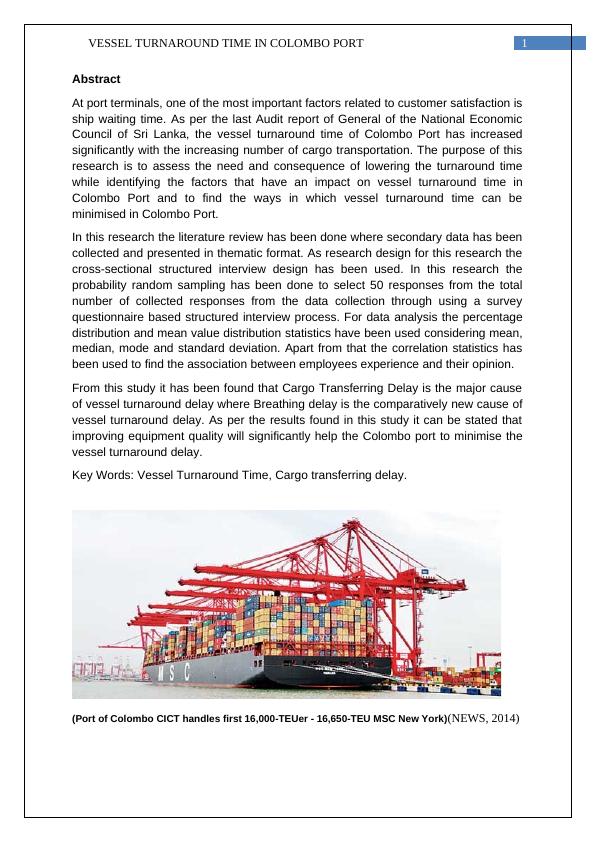
2VESSEL TURNAROUND TIME IN COLOMBO PORT
Table of content
Chapter1: Introduction........................................................................................................................... 5
1.1 Background................................................................................................................................. 5
1.2 Problem Statement...................................................................................................................... 7
1.3 Research questions..................................................................................................................... 8
1.4 Aims and objectives..................................................................................................................... 8
1.5 Research Structure...................................................................................................................... 9
Chapter 2: Literature review.................................................................................................................. 9
2.1 Introduction:................................................................................................................................. 9
2.2 Colombo port and trade activity.................................................................................................10
2.3 Turnaround time and its impact.................................................................................................11
2.4 Factors associated with turnaround time...................................................................................13
2.5 Porting strategies....................................................................................................................... 16
2.6 Summary................................................................................................................................... 17
2.7 Literature Gap........................................................................................................................... 18
Chapter 3: Methodology...................................................................................................................... 19
3.1 Introduction................................................................................................................................ 19
3.2 Research Philosophy................................................................................................................. 19
3.3 Research Approach................................................................................................................... 19
3.4 Research Design....................................................................................................................... 20
3.5 Target Population and sampling................................................................................................ 20
3.6 Data collection........................................................................................................................... 21
3.7 Data analysis............................................................................................................................. 21
3.8 Ethical Consideration................................................................................................................. 21
3.9 Summary................................................................................................................................... 22
Chapter 4: Analysis & discussion......................................................................................................... 23
4.1 Introduction:............................................................................................................................... 23
4.2 Demographic study.................................................................................................................... 23
4.3 Turnaround delay causes.......................................................................................................... 26
4.4 Suggestions............................................................................................................................... 30
4.5 Other factors.............................................................................................................................. 30
4.6Discussion.................................................................................................................................. 32
4.6 Summary................................................................................................................................... 34
Chapter 5: Conclusion and recommendation:......................................................................................36
5.1 Summary:.................................................................................................................................. 36
5.2 Linking with Objectives:............................................................................................................. 36
5.3 Conclusion................................................................................................................................. 37
5.4 Limitations and further research................................................................................................38
References.......................................................................................................................................... 40
Appendices.......................................................................................................................................... 43
Appendix 1: Business Dissertation Supervision Monitoring Form...................................................43
Appendix 2: Survey......................................................................................................................... 46
List of Tables
Table of content
Chapter1: Introduction........................................................................................................................... 5
1.1 Background................................................................................................................................. 5
1.2 Problem Statement...................................................................................................................... 7
1.3 Research questions..................................................................................................................... 8
1.4 Aims and objectives..................................................................................................................... 8
1.5 Research Structure...................................................................................................................... 9
Chapter 2: Literature review.................................................................................................................. 9
2.1 Introduction:................................................................................................................................. 9
2.2 Colombo port and trade activity.................................................................................................10
2.3 Turnaround time and its impact.................................................................................................11
2.4 Factors associated with turnaround time...................................................................................13
2.5 Porting strategies....................................................................................................................... 16
2.6 Summary................................................................................................................................... 17
2.7 Literature Gap........................................................................................................................... 18
Chapter 3: Methodology...................................................................................................................... 19
3.1 Introduction................................................................................................................................ 19
3.2 Research Philosophy................................................................................................................. 19
3.3 Research Approach................................................................................................................... 19
3.4 Research Design....................................................................................................................... 20
3.5 Target Population and sampling................................................................................................ 20
3.6 Data collection........................................................................................................................... 21
3.7 Data analysis............................................................................................................................. 21
3.8 Ethical Consideration................................................................................................................. 21
3.9 Summary................................................................................................................................... 22
Chapter 4: Analysis & discussion......................................................................................................... 23
4.1 Introduction:............................................................................................................................... 23
4.2 Demographic study.................................................................................................................... 23
4.3 Turnaround delay causes.......................................................................................................... 26
4.4 Suggestions............................................................................................................................... 30
4.5 Other factors.............................................................................................................................. 30
4.6Discussion.................................................................................................................................. 32
4.6 Summary................................................................................................................................... 34
Chapter 5: Conclusion and recommendation:......................................................................................36
5.1 Summary:.................................................................................................................................. 36
5.2 Linking with Objectives:............................................................................................................. 36
5.3 Conclusion................................................................................................................................. 37
5.4 Limitations and further research................................................................................................38
References.......................................................................................................................................... 40
Appendices.......................................................................................................................................... 43
Appendix 1: Business Dissertation Supervision Monitoring Form...................................................43
Appendix 2: Survey......................................................................................................................... 46
List of Tables
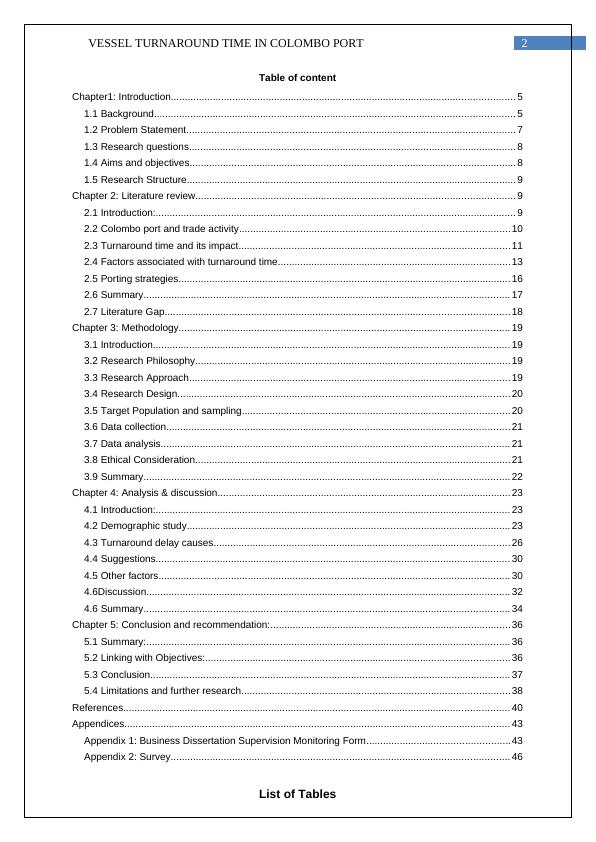
3VESSEL TURNAROUND TIME IN COLOMBO PORT
Table 4.1: Demographic Study – Gender............................................................................................ 22
Table 4.2: Demographic Study – Age.................................................................................................. 22
Table 4.3: Demographic Study – origin................................................................................................ 23
Table 4.4: Demographic Study – Job area..........................................................................................24
Table 4.5: Demographic Study – Experience in industry.....................................................................24
Table 4.6: Demographic Study – Experience in CICT.........................................................................25
Table 4.7: Major cause of turnaround delay........................................................................................ 25
Table 4.8: Correlation of opinions and experience...............................................................................26
Table 4.9: Major cause of Breathing Delay.......................................................................................... 27
Table 4.10: Major cause of Cargo Transfer delay................................................................................27
Table 4.11: Major cause of Cargo Availability Delay............................................................................28
Table 4.12: Suggestions to minimise the delays..................................................................................29
Table 4.13: Is Port Opening Adequate................................................................................................. 30
Table 4.14: Other Major Factors.......................................................................................................... 30
Table 5.1: Linking with Objectives....................................................................................................... 36
Table 4.1: Demographic Study – Gender............................................................................................ 22
Table 4.2: Demographic Study – Age.................................................................................................. 22
Table 4.3: Demographic Study – origin................................................................................................ 23
Table 4.4: Demographic Study – Job area..........................................................................................24
Table 4.5: Demographic Study – Experience in industry.....................................................................24
Table 4.6: Demographic Study – Experience in CICT.........................................................................25
Table 4.7: Major cause of turnaround delay........................................................................................ 25
Table 4.8: Correlation of opinions and experience...............................................................................26
Table 4.9: Major cause of Breathing Delay.......................................................................................... 27
Table 4.10: Major cause of Cargo Transfer delay................................................................................27
Table 4.11: Major cause of Cargo Availability Delay............................................................................28
Table 4.12: Suggestions to minimise the delays..................................................................................29
Table 4.13: Is Port Opening Adequate................................................................................................. 30
Table 4.14: Other Major Factors.......................................................................................................... 30
Table 5.1: Linking with Objectives....................................................................................................... 36
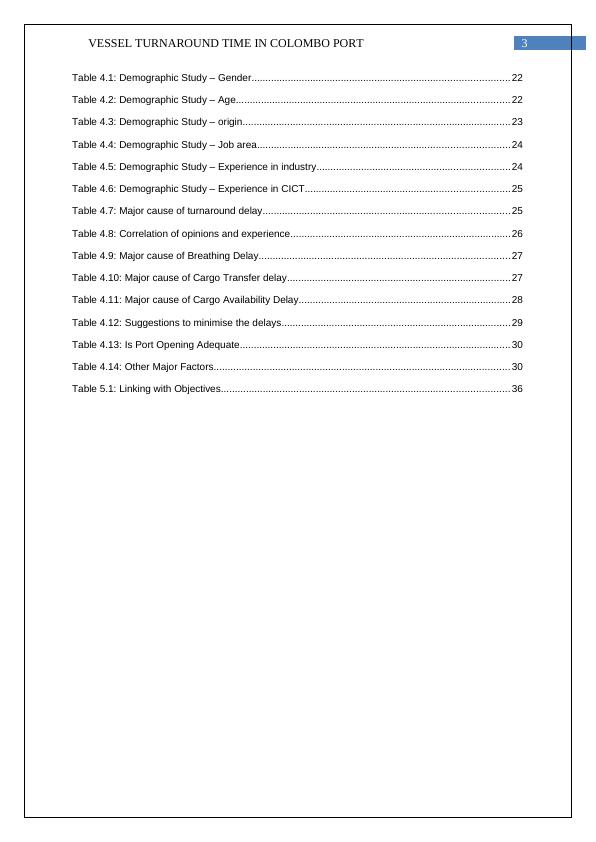
4VESSEL TURNAROUND TIME IN COLOMBO PORT
List of figures
Figure 1:1Volume of port of Colombo.................................................................................................... 7
Figure 1:2MV.ONE AQUILAberthed in CICT......................................................................................... 9
Figure 3:1(source:Srilanka Port Authority & Daily FT)(Hundlani, 2018)...............................................22
Figure 4:1 Pie chart for gender percentage.........................................................................................23
Figure 4:2 Pie chart for age percentage.............................................................................................. 23
Figure 4:3 Pie chart for Job area percentage......................................................................................25
Figure 4:4 Major cause of VTT delays................................................................................................. 26
Figure 4:5 Major cause of cargo transfer delays..................................................................................29
Figure 4:6suggestions......................................................................................................................... 30
Figure 4:6 Mean Values o other factors............................................................................................... 31
Figure 4:7 Comparing the Single Cycle and Dual Cycle QC Movement (Zhang & Kim, 2009)............34
Figure 5:1 Conceptual Framework (Source:((Easterby-Smith, et al., 2008)........................................39
Figure 5:2 Factors for terminal delay (Source: Dhingra et al. 2017)(Dhingra, et al., 2017)..................39
List of figures
Figure 1:1Volume of port of Colombo.................................................................................................... 7
Figure 1:2MV.ONE AQUILAberthed in CICT......................................................................................... 9
Figure 3:1(source:Srilanka Port Authority & Daily FT)(Hundlani, 2018)...............................................22
Figure 4:1 Pie chart for gender percentage.........................................................................................23
Figure 4:2 Pie chart for age percentage.............................................................................................. 23
Figure 4:3 Pie chart for Job area percentage......................................................................................25
Figure 4:4 Major cause of VTT delays................................................................................................. 26
Figure 4:5 Major cause of cargo transfer delays..................................................................................29
Figure 4:6suggestions......................................................................................................................... 30
Figure 4:6 Mean Values o other factors............................................................................................... 31
Figure 4:7 Comparing the Single Cycle and Dual Cycle QC Movement (Zhang & Kim, 2009)............34
Figure 5:1 Conceptual Framework (Source:((Easterby-Smith, et al., 2008)........................................39
Figure 5:2 Factors for terminal delay (Source: Dhingra et al. 2017)(Dhingra, et al., 2017)..................39
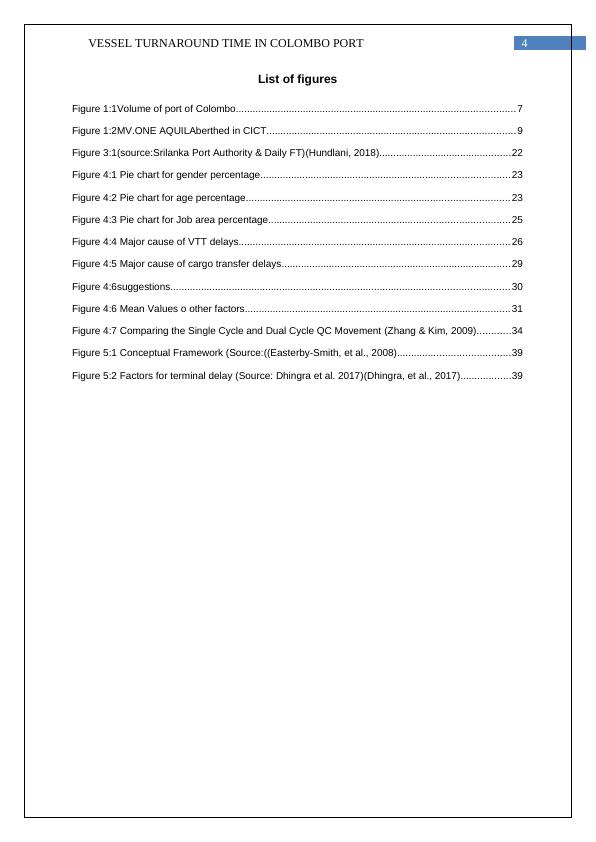
5VESSEL TURNAROUND TIME IN COLOMBO PORT
Chapter 1: Introduction
1.1 Background
Competitiveness among port operators have increased and minimization of
terminal charges is important to attract port users for their economic returns.
Reduction of Vessel Turnaround Time (VTT) has an impact on vessel operating
costs. Port operators and their terminal operators have to consider decreasing VTT
for benchmarking good productivity and performance (Mokhtar & Shah, 2006). In
marine port where mostly cargo transpiration and shipment operations are done, the
major performance evaluating factor is delay. This delay refers to the time required
toundock a ship after the decided time of undocking. Between docking and
undocking process several major procedures take place in a shipyard such as
unloading cargo, preparing new crew members, checking new cargo, transporting
new cargo through cargo carrying cranes, loading new cargo, pilotage, assigning
new crew members and many more(Drewry, 2016 February). All these operations
should be synchronised in a very precise manner to ensure the vessel turnaround
efficiency. The total time required from docking a vessel to undocking a vessel with
cargo is called vessel turnaround time and the delay caused in this systematic
process is called vessel turnaround delay.
In port container terminals, ship waiting time includes various types of queue.
The study's major relevance in reducing turnaround times is that time is considered
the most important factor for shipping and delivering goods than the cost of
transporting goods. One of the most important factors associated with customer
satisfaction at port terminals is ship waiting time. One of the major contributors is the
competitive advantage of a port terminal ship waiting time. Waiting and queuing
times in port terminal berthing area is the biggest problem faced by port managers.
Low-waited port terminals can attract more ships than port terminals. Port
management is concerned with service rates at port terminals because it can
dramatically increase the efficiency of service port rates. On the other hand, ship /
control and port customers are concerned about waiting time, meaning they have
tried to select a port terminal with lower service waiting time. Long waiting times
have a negative impact on port terminal efficiency and ship managers prefer to land
with low waiting time and high efficiency at a port terminal. Port management at port
terminals focused on the port output rate that affects the productivity of port
terminals. Additionally, port customers and ship management are concerned with
terminal waiting time.
The turnaround time mainly depends on the transportation of cargo, breathing
operations, and availability of the cargo. Here the breathing operations refers to the
process of starting up the departure or undocking process of a ship or vessel
including assigning pilot, weather alignment, berth preparation, crew or gang
member assigning and others. The cargo loading and unloading processes are fall
under the cargo transportation system. The cargo availability depends on licence
clearance of goods and cargo stocking. The turnaround time is dependent on the
Chapter 1: Introduction
1.1 Background
Competitiveness among port operators have increased and minimization of
terminal charges is important to attract port users for their economic returns.
Reduction of Vessel Turnaround Time (VTT) has an impact on vessel operating
costs. Port operators and their terminal operators have to consider decreasing VTT
for benchmarking good productivity and performance (Mokhtar & Shah, 2006). In
marine port where mostly cargo transpiration and shipment operations are done, the
major performance evaluating factor is delay. This delay refers to the time required
toundock a ship after the decided time of undocking. Between docking and
undocking process several major procedures take place in a shipyard such as
unloading cargo, preparing new crew members, checking new cargo, transporting
new cargo through cargo carrying cranes, loading new cargo, pilotage, assigning
new crew members and many more(Drewry, 2016 February). All these operations
should be synchronised in a very precise manner to ensure the vessel turnaround
efficiency. The total time required from docking a vessel to undocking a vessel with
cargo is called vessel turnaround time and the delay caused in this systematic
process is called vessel turnaround delay.
In port container terminals, ship waiting time includes various types of queue.
The study's major relevance in reducing turnaround times is that time is considered
the most important factor for shipping and delivering goods than the cost of
transporting goods. One of the most important factors associated with customer
satisfaction at port terminals is ship waiting time. One of the major contributors is the
competitive advantage of a port terminal ship waiting time. Waiting and queuing
times in port terminal berthing area is the biggest problem faced by port managers.
Low-waited port terminals can attract more ships than port terminals. Port
management is concerned with service rates at port terminals because it can
dramatically increase the efficiency of service port rates. On the other hand, ship /
control and port customers are concerned about waiting time, meaning they have
tried to select a port terminal with lower service waiting time. Long waiting times
have a negative impact on port terminal efficiency and ship managers prefer to land
with low waiting time and high efficiency at a port terminal. Port management at port
terminals focused on the port output rate that affects the productivity of port
terminals. Additionally, port customers and ship management are concerned with
terminal waiting time.
The turnaround time mainly depends on the transportation of cargo, breathing
operations, and availability of the cargo. Here the breathing operations refers to the
process of starting up the departure or undocking process of a ship or vessel
including assigning pilot, weather alignment, berth preparation, crew or gang
member assigning and others. The cargo loading and unloading processes are fall
under the cargo transportation system. The cargo availability depends on licence
clearance of goods and cargo stocking. The turnaround time is dependent on the
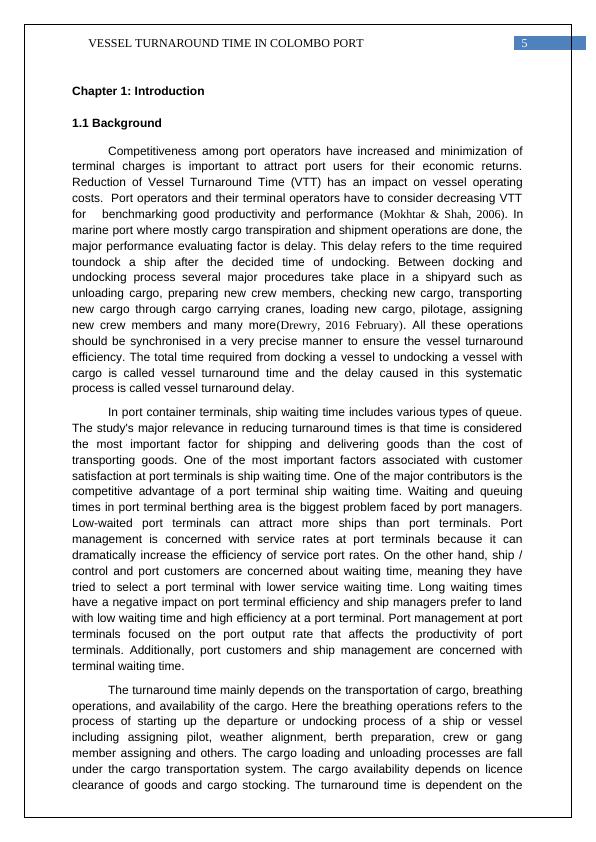
6VESSEL TURNAROUND TIME IN COLOMBO PORT
performance and organisation in the ports and may hence vary. The increased
demand for maritime trade and shipping has been met by the port committee with a
decision of expansion. More harbours have been added to accommodate the
increased number of vessels. This causes stress on the previously organised system
as changes have to be made to account for more number of ships and goods. Hence
turnaround time is directly related to port efficiency.
CICT, which commenced operations in July 2013, manages the Colombo South
Terminal of the Port of Colombo. The first and currently the only deep-water terminal
in South Asia equipped with facilities to handle the largest vessels afloat with 18m
depth. The commencement of CICT’s operations is widely credited as the factor in
the Port of Colombo achieving double digit growth in 2014 after a lapse of over 10
years. In just three years of operation, CICT has brought some of the largest vessels
plying the Asia-Europe routes to Colombo. Of these, Milan Maersk (20,568 TEU),
MSC Maya (19,224 TEU), Mogens Maersk (18,300 TEU), MSC New York (16,652
TEU), CMA CGM Marco Polo (16,020 TEU), Edith Maersk and EMC Thalassa Hellas
(each 14,000 plus TEUs) and their sister vessels are now regular callers at CICT.
Volume – port of Colombo
2012
2013
2014
2015
2016
2017
2018
4.26 4.31
4.91 5.19
5.73
6.45
7.01
TEUs million
Figure 1:1Volume of port of Colombo
1.2 Problem Statement
Sri Lanka is a strategic naval link between West Asia and South East Asia
and the port of Colombo handle container, bulk and tanker vessels. It is one of
busiest port around the world where a huge number of employees work together in a
very systematic way to maintain all the porting and shipping operations. As per the
performance and organisation in the ports and may hence vary. The increased
demand for maritime trade and shipping has been met by the port committee with a
decision of expansion. More harbours have been added to accommodate the
increased number of vessels. This causes stress on the previously organised system
as changes have to be made to account for more number of ships and goods. Hence
turnaround time is directly related to port efficiency.
CICT, which commenced operations in July 2013, manages the Colombo South
Terminal of the Port of Colombo. The first and currently the only deep-water terminal
in South Asia equipped with facilities to handle the largest vessels afloat with 18m
depth. The commencement of CICT’s operations is widely credited as the factor in
the Port of Colombo achieving double digit growth in 2014 after a lapse of over 10
years. In just three years of operation, CICT has brought some of the largest vessels
plying the Asia-Europe routes to Colombo. Of these, Milan Maersk (20,568 TEU),
MSC Maya (19,224 TEU), Mogens Maersk (18,300 TEU), MSC New York (16,652
TEU), CMA CGM Marco Polo (16,020 TEU), Edith Maersk and EMC Thalassa Hellas
(each 14,000 plus TEUs) and their sister vessels are now regular callers at CICT.
Volume – port of Colombo
2012
2013
2014
2015
2016
2017
2018
4.26 4.31
4.91 5.19
5.73
6.45
7.01
TEUs million
Figure 1:1Volume of port of Colombo
1.2 Problem Statement
Sri Lanka is a strategic naval link between West Asia and South East Asia
and the port of Colombo handle container, bulk and tanker vessels. It is one of
busiest port around the world where a huge number of employees work together in a
very systematic way to maintain all the porting and shipping operations. As per the
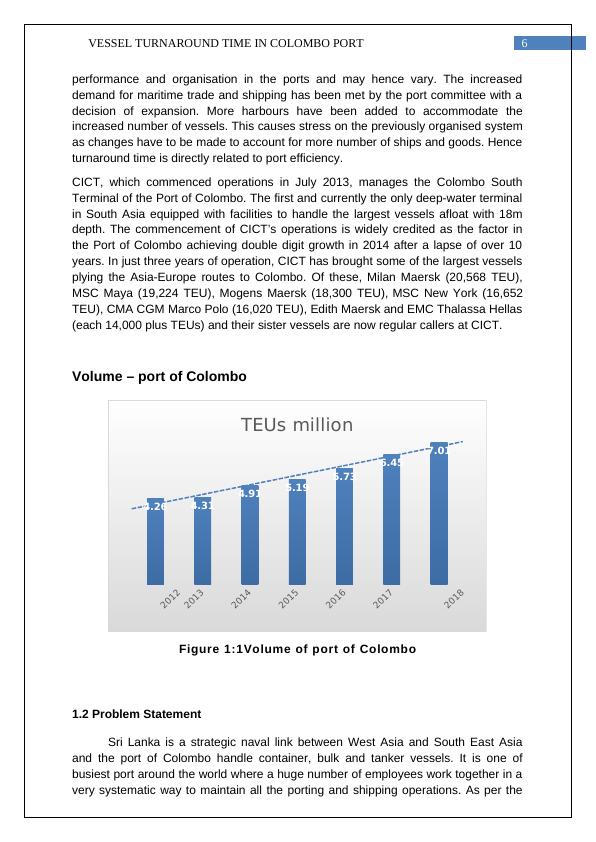
7VESSEL TURNAROUND TIME IN COLOMBO PORT
last Audit report of General of the National Economic Council of Sri Lanka, the
vessel turnaround time of Colombo Port has increased 15% from 2017 to 2018 with
the increasing number of cargo transportation.Sri Lanka Port Authority (SLPA) has
also highlighted the commercial and developmental issues caused by delay in East
Container Terminal (ECT). The chairman of SLPA also stated that with this
increasing rate of vessel turnaround delay the import export business operation in Sri
Lanka is going to be distracted significantly within next 5 years. From different
sources different potential reason has been reported such as lack of facilitation, poor
workforce strength, lack of advancement and others. However, no research has
been done till now regarding the current situation in Colombo port and the underlying
factors behind the vessel turnaround delay. Efficient scheduling and implementation
may require more labour and machinery from the port to be in direct contact with the
work. This is the tactical level part. The level of operation depends on the efficiency
of the work and technology involved. All the required activities should be identified
and planned keeping accordance to their schedule and failure of the ships to
maintain the time keeping accordance to their schedule will result in huge loss for the
ship as well as for the traffic at the sea route since it will become unfavourable
creating further delay. It is difficult to control the time required in travelling to much of
an extent. That is why the focus needs to be given to the period spent by the ships
on docks. The turnaround time is dependent on the performance and organisation in
the ports and may hence vary. The increased demand for maritime trade and
shipping has been met by the port committee with a decision of expansion.
1.3 Research questions
As per the problem statement discussed earlier, it can be clearly stated that
there are many unknown factors associated with turnaround time of CICT that must
understood to address the current problematic situation in CICT and other ports
across the globe. The in-depth needs and consequence of turnaround time are
unknown. The major factors that affect turnaround time are unknown. The strategies
to minimise the current problems regarding vessel turnaround time are also
unknown. Therefore, the research questions of this research are:
What are the needs and consequences of lowering the turnaround time?
What are the major factors impact on vessel turnaround time?
What are the strategies to minimise vessel turnaround time?
1.4 Aims and objectives
The aim of the project is to study the impacting factors of low turnaround time
in the Colombo Port. The Terminal chosen for the study was the Colombo
International Container Terminals (CICT) which is the only deep-water terminal in
South Asia equipped with facilities to handle any kind of larger vessels. This will be
conducted over three months.
To assess the need and consequence of lowering the turnaround time
To identify the factors that have an impact on vessel turnaround time
last Audit report of General of the National Economic Council of Sri Lanka, the
vessel turnaround time of Colombo Port has increased 15% from 2017 to 2018 with
the increasing number of cargo transportation.Sri Lanka Port Authority (SLPA) has
also highlighted the commercial and developmental issues caused by delay in East
Container Terminal (ECT). The chairman of SLPA also stated that with this
increasing rate of vessel turnaround delay the import export business operation in Sri
Lanka is going to be distracted significantly within next 5 years. From different
sources different potential reason has been reported such as lack of facilitation, poor
workforce strength, lack of advancement and others. However, no research has
been done till now regarding the current situation in Colombo port and the underlying
factors behind the vessel turnaround delay. Efficient scheduling and implementation
may require more labour and machinery from the port to be in direct contact with the
work. This is the tactical level part. The level of operation depends on the efficiency
of the work and technology involved. All the required activities should be identified
and planned keeping accordance to their schedule and failure of the ships to
maintain the time keeping accordance to their schedule will result in huge loss for the
ship as well as for the traffic at the sea route since it will become unfavourable
creating further delay. It is difficult to control the time required in travelling to much of
an extent. That is why the focus needs to be given to the period spent by the ships
on docks. The turnaround time is dependent on the performance and organisation in
the ports and may hence vary. The increased demand for maritime trade and
shipping has been met by the port committee with a decision of expansion.
1.3 Research questions
As per the problem statement discussed earlier, it can be clearly stated that
there are many unknown factors associated with turnaround time of CICT that must
understood to address the current problematic situation in CICT and other ports
across the globe. The in-depth needs and consequence of turnaround time are
unknown. The major factors that affect turnaround time are unknown. The strategies
to minimise the current problems regarding vessel turnaround time are also
unknown. Therefore, the research questions of this research are:
What are the needs and consequences of lowering the turnaround time?
What are the major factors impact on vessel turnaround time?
What are the strategies to minimise vessel turnaround time?
1.4 Aims and objectives
The aim of the project is to study the impacting factors of low turnaround time
in the Colombo Port. The Terminal chosen for the study was the Colombo
International Container Terminals (CICT) which is the only deep-water terminal in
South Asia equipped with facilities to handle any kind of larger vessels. This will be
conducted over three months.
To assess the need and consequence of lowering the turnaround time
To identify the factors that have an impact on vessel turnaround time

End of preview
Want to access all the pages? Upload your documents or become a member.
Related Documents
Optimization of the Delivery Process of the Machinery Leasing Logisticslg...
|51
|20652
|50
Ship Management: Enhancing Efficiency and Cost Optimization in the Shipping Industrylg...
|49
|11965
|196
Ethical Approval Application Formlg...
|8
|2031
|353
Bottle Water Vs Tap Water Case Study 2022lg...
|45
|13753
|11
Sociology Outcomes & Assessmentlg...
|47
|12111
|25
Importance of Employee Engagement and Its Development to Company Growthlg...
|49
|11656
|463
